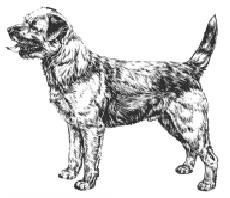Border Terrier
General Information - Border Terrier

Group:
Terrier
Size:
Small
Lifespan:
12-14 years
Exercise:
Moderate
Grooming:
Moderate
Trainability:
Easy
Watchdog Ability:
High
Protection Ability:
Very low
Area of Origin:
Border of Scotland
and England
Date of Origin:
1700s
Other Names:
None
Original Function:
Fox bolting, ratting
History
The Border Terrier was originally bred in the Cheviot Hills area near the border between England and Scotland to help farmers drive predatory foxes from their dens and kill them. This sturdy little fellow has long enough legs and enough stamina to keep up with a horse, even though he is quite small. The bold little Border Terrier has also been used to hunt marten, otter and the fierce badger. The breed was once known as the Coquetdale Terrier (among other names), but the name Border Terrier, taken from the Border Hunt, was adopted in 1870. As with most terriers, the Border Terrier gradually began to be taken into the home. Today due to his winning personality, adaptability and friendliness, the breed is highly esteemed as a companion dog, yet he can still serve as a fine farm dog, helping to control vermin.
Temperament
Lively and alert but also mild-mannered, the Border Terrier is a loving good natured companion that loves being with its owner. It is generally good with other dogs and cats, but not with rodents. It is very good with children and makes a good companion for people of all ages. It digs, and some bark. Some are talented escape artists.
Upkeep
The Border likes activity and needs a good walk on leash, a vigorous game session or an off-lead expedition in a safe area every day. It can live outdoors in temperate climates, but it does much better when allowed to divide its time between house and yard. The Border Terrier has a weather resistant coat with a hard, wiry outer coat and soft undercoat repels most dirt. Its harsh coat needs brushing weekly, plus stripping of dead hairs about four times yearly to maintain its clean outline.
Border Terrier
A breed standard is the guideline which describes the ideal characteristics, temperament, and appearance of a breed and ensures that the breed is fit for function with soundness essential. Breeders and judges should at all times be careful to avoid obvious conditions and exaggerations, as well as being mindful of features which could be detrimental in any way to the health, welfare or soundness of this breed.
Breed Standard - Border Terrier

Characteristics: The Border Terrier is essentially a working Terrier. It should be able to follow a horse and must combine activity with gameness.
Head And
Skull: Head like that of an otter, moderately broad in skull, with a short strong muzzle; a black nose is preferable but a liver or flesh:coloured one is not a serious fault.
Eyes: Dark, with keen expression.
Ears: Small, V:shaped, of moderate thickness and dropping forward close to the cheek.
Mouth: Teeth should have a scissor:like grip, with the top teeth slightly in front of the lower, but level mouth is quite acceptable. An undershot or overshot mouth is a major fault and highly undesirable.
Neck: Of moderate length.
Forequarters: Forelegs straight and not too heavy in bone.
Body: Deep and narrow and fairly long; ribs carried well back, but not oversprung, as a terrier should be capable of being spanned by both hands behind the shoulder.
Hindquarters: Racy. Loin strong.
Feet: Small with thick pads.
Tail: Moderately short and fairly thick at the base, then tapering, set high and carried gaily but not curled over the back.
Coat: Harsh and dense with close undercoat. The skin must be thick.
Colour: Red, wheaten, grizzle and tan or blue and tan.
Weight and
Size:
Weight: Dogs between 13:15.5 lbs (5.8:7 kg); Bitches between 11.5:14 lbs (5.2:6.3 kg).
Note: Male animals should have two apparently normal testicles fully descended into the scrotum.
[NZKC No 216
[FCI No 10
Copyright NZKC
Print 01:JAN:02
Any departure from the foregoing points should be considered a fault and the seriousness with which the fault should be regarded should be in exact proportion to its degree and its effect upon the health and welfare of the dog and on the dog’s ability to perform its traditional work.




